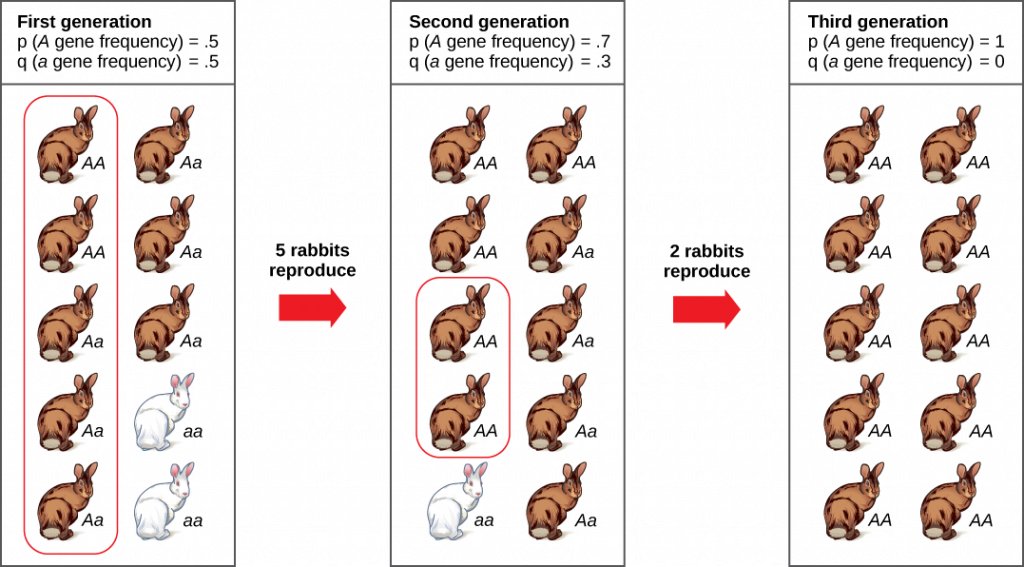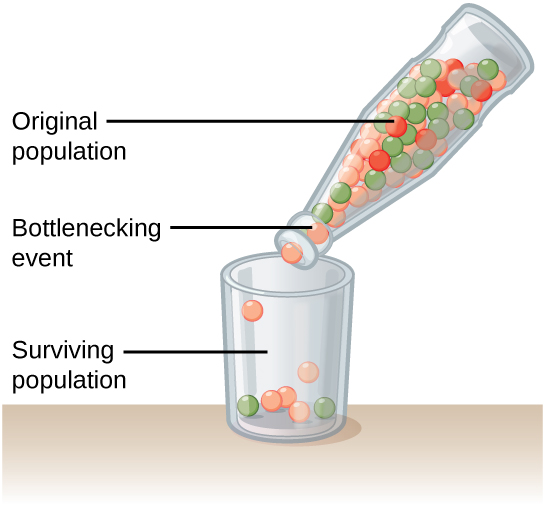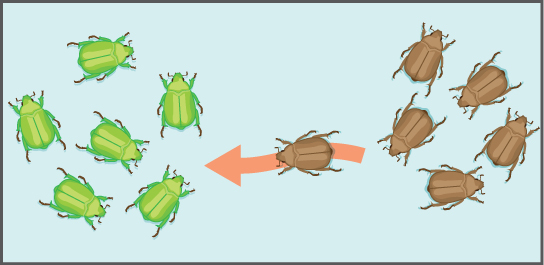Theme 1: What Makes Us Unique?
1.4 Mechanisms of Evolution
When certain genes become more or less common in the population over generations, we refer to this change as evolution. Although natural selection is the mechanism of evolution most commonly discussed, other evolutionary mechanisms also change the frequencies of traits (and the genes that control them) in populations. These include mutation, genetic drift and migration.
*
Natural Selection
Natural selection, discussed in the previous chapter, is the mechanism of evolution that explains how species can become better adapted to their environment. Depending on the environmental conditions, certain traits may confer an advantage or disadvantage to the individuals that possess them, relative to others in the population. If a certain trait confers an advantage, then the individual possessing the trait may have more offspring than those with other traits. If the trait is heritable, then the genes that give rise to the trait will be more common in the next generation. If conditions remain the same, those offspring, which are carrying the same trait, will also benefit, and pass the genes that give rise to this trait on to their own offspring. Over time, the advantageous trait (aka adaptation) will become more common in the population.
*
Mutation
Mutation is a source of variation in a population. Mutation is a change in the DNA sequence of the gene. In some cases a change in the DNA will change the protein produced. The change in frequency resulting from a mutation in one individual is small, so its effect on evolution is small unless it interacts with one of the other factors, such as selection. A mutation may produce an allele that is selected against, selected for, or selectively neutral. Harmful mutations are removed from the population by selection and will generally only be found in very low frequencies equal to the mutation rate. Beneficial mutations will spread through the population through selection, although that initial spread is slow. Whether or not a mutation is beneficial or harmful is determined by whether it helps an organism survive to sexual maturity and reproduce. It should be noted that mutation is the ultimate source of genetic variation in all populations—new alleles, and, therefore, new genetic variations arise through mutation.
*
Genetic Drift
Another way the frequencies of certain genes can change is genetic drift (Figure 1), which is simply the effect of chance. Genetic drift is most important in small populations. Because the genes in an offspring generation are a random sample of the genes in the parent generation, some versions of a gene may not make it into the next generation due to chance events. If one individual in a population of ten individuals happens to die before it leaves any offspring to the next generation, all of its genes—a tenth of the population’s gene pool—will be suddenly lost. In a population of 100, that 1 individual represents only 1 percent of the overall gene pool; therefore, it has much less impact on the population’s genetic structure and is unlikely to remove all copies of even a relatively rare gene.
Imagine a population of ten individuals, half with a version of a gene we will call A and half with a version of a gene we will call a. In a stable population, the next generation will also have ten individuals. Choose that generation randomly by flipping a coin ten times and let heads be A and tails be a. It is unlikely that the next generation will have exactly half of each gene. There might be six of one and four of the other, or some different set of frequencies. Thus, the frequencies have changed and evolution has occurred. A coin will no longer work to choose the next generation (because the odds are no longer one half for each gene). The frequency in each generation will drift up and down on what is known as a random walk until at one point either all A or all a are chosen and that version of the gene is fixed from that point on. This could take a very long time for a large population. The effect of drift on frequencies is greater the smaller a population is.

Genetic drift can also be magnified by natural or human-caused events, such as a disaster that randomly kills a large portion of the population, which is known as the bottleneck effect that results in a large portion of the gene pool suddenly being wiped out (Figure 2). In one fell swoop, the genetic structure of the survivors becomes the genetic structure of the entire population, which may be very different from the pre-disaster population. The disaster must be one that kills for reasons unrelated to the organism’s traits, such as a hurricane or lava flow.

Another scenario in which populations might experience a strong influence of genetic drift is if some portion of the population leaves to start a new population in a new location, or if a population gets divided by a physical barrier of some kind. In this situation, those individuals are unlikely to be representative of the entire population which results in the founder effect. The founder effect occurs when the genetic structure matches that of the new population’s founding fathers and mothers. The founder effect is believed to have been a key factor in the genetic history of the Afrikaner population of Dutch settlers in South Africa, as evidenced by mutations that are common in Afrikaners but rare in most other populations. This is likely due to a higher-than-normal proportion of the founding colonists, which were a small sample of the original population, carried these mutations. As a result, the population expresses unusually high incidences of Huntington’s disease (HD) and Fanconi anemia (FA), a genetic disorder known to cause bone marrow and congenital abnormalities, and even cancer[1].
*
Gene Flow
Another important evolutionary force is gene flow, or the flow of genes in and out of a population resulting from the migration of individuals or gametes (Figure 3). While some populations are fairly stable, others experience more flux. Many plants, for example, send their seeds far and wide, by wind or in the guts of animals; these seeds may introduce genes common in the source population to a new population in which they are rare.

*
Section Summary
There are four factors that can change the frequencies of genes in a population. Natural selection works by selecting for genes that confer beneficial traits or behaviors, while selecting against those for deleterious qualities. Mutations introduce new versions of genes into populations. Genetic drift stems from the chance occurrence that some individuals have more offspring than others and results in changes in gene frequencies that are random in direction. When individuals leave or join the population, gene frequencies can change as a result of gene flow.
*
Glossary
- bottleneck effect
- the magnification of genetic drift as a result of natural events or catastrophes
- founder effect
- a magnification of genetic drift in a small population that migrates away from a large parent population carrying with it an unrepresentative set of alleles
- gene flow
- the movement of genetic information across populations due to the migration of individuals or gametes (sex cells- such as a plant’s pollen)
- genetic drift
- random changes in trait frequencies over time
- A. J. Tipping et al., “Molecular and Genealogical Evidence for a Founder Effect in Fanconi Anemia Families of the Afrikaner Population of South Africa,” PNAS 98, no. 10 (2001): 5734-5739, doi: 10.1073/pnas.091402398. ↵

